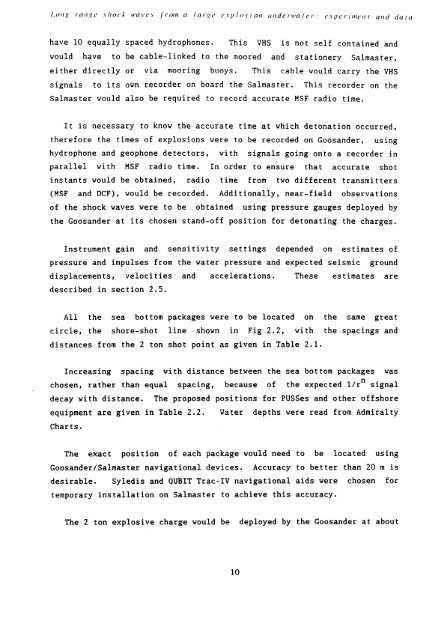Download (6Mb) - NERC Open Research Archive
Download (6Mb) - NERC Open Research Archive
Download (6Mb) - NERC Open Research Archive
You also want an ePaper? Increase the reach of your titles
YUMPU automatically turns print PDFs into web optimized ePapers that Google loves.
.Ollg rallge shock waves from a {arge exp{osiOll underwater: experimellt alld data<br />
have 10 equally spaced hydrophones. This VHS is not self contained and<br />
would have to be cable-linked to the moored and stationery Salmaster,<br />
either directly or via mooring buoys. This cable would carry the VHS<br />
signals to its own recorder on board the Salmaster. This recorder on the<br />
Salmaster would also be required to record accurate MSF radio time.<br />
It is necessary to know the accurate time at which detonation occurred,<br />
therefore the times of explosions were to be recorded on Goosander, using<br />
hydrophone and geophone detectors, with signals going onto a recorder in<br />
parallel with MSF radio time. In order to ensure that accurate shot<br />
instants would be obtained, radio time from two different transmitters<br />
(MSF and DCF), would be recorded. Additionally, near-field observations<br />
of the shock waves were to be obtained using pressure gauges deployed by<br />
the Goosander at its chosen stand-off position for detonating the charges.<br />
Instrument gain and sensitivity settings depended on estimates of<br />
pressure and impulses from the water pressure and expected seismic ground<br />
displacements, velocities and accelerations. These estimates are<br />
described in section 2.5.<br />
All the sea bottom packages were to be located on<br />
circle, the shore-shot line shown in Fig 2.2, with<br />
distances from the 2 ton shot point as given in Table 2.1.<br />
the same great<br />
the spacings and<br />
Increasing spacing with distance between the sea bottom packages was<br />
chosen, rather than equal spacing, because of the expected 1/r n signal<br />
decay with distance. The proposed positions for PUSSes and other offshore<br />
equipment are given in Table 2.2. Water depths were read from Admiralty<br />
Charts.<br />
The exact position of each package would need to be located using<br />
GoosanderlSalmaster navigational devices. Accuracy to better than 20 m is<br />
desirable. Syledis and QUBIT Trac-IV navigational aids were chosen for<br />
temporary installation on Salmaster to achieve this accuracy.<br />
The 2 ton explosive charge would be deployed by the Goosander at about<br />
10
















